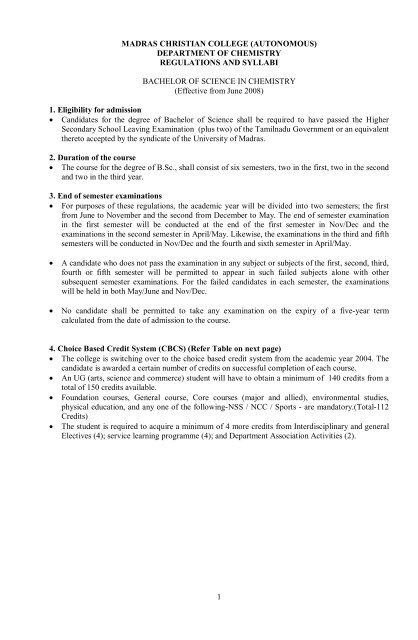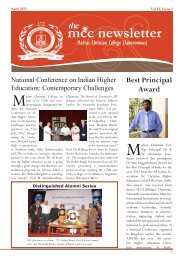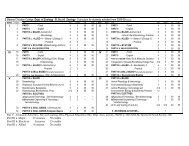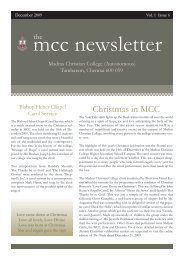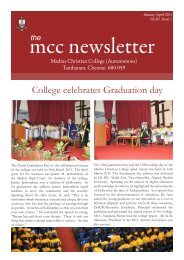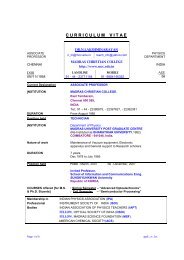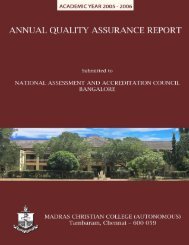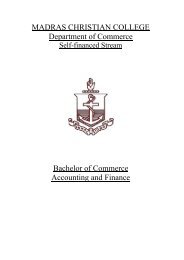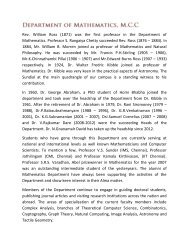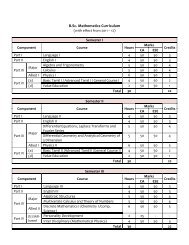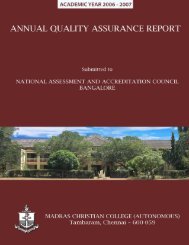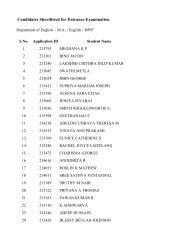BSc Curriculum - Madras Christian College
BSc Curriculum - Madras Christian College
BSc Curriculum - Madras Christian College
Create successful ePaper yourself
Turn your PDF publications into a flip-book with our unique Google optimized e-Paper software.
MADRAS CHRISTIAN COLLEGE (AUTONOMOUS)<br />
DEPARTMENT OF CHEMISTRY<br />
REGULATIONS AND SYLLABI<br />
BACHELOR OF SCIENCE IN CHEMISTRY<br />
(Effective from June 2008)<br />
1. Eligibility for admission<br />
• Candidates for the degree of Bachelor of Science shall be required to have passed the Higher<br />
Secondary School Leaving Examination (plus two) of the Tamilnadu Government or an equivalent<br />
thereto accepted by the syndicate of the University of <strong>Madras</strong>.<br />
2. Duration of the course<br />
• The course for the degree of B.Sc., shall consist of six semesters, two in the first, two in the second<br />
and two in the third year.<br />
3. End of semester examinations<br />
• For purposes of these regulations, the academic year will be divided into two semesters; the first<br />
from June to November and the second from December to May. The end of semester examination<br />
in the first semester will be conducted at the end of the first semester in Nov/Dec and the<br />
examinations in the second semester in April/May. Likewise, the examinations in the third and fifth<br />
semesters will be conducted in Nov/Dec and the fourth and sixth semester in April/May.<br />
• A candidate who does not pass the examination in any subject or subjects of the first, second, third,<br />
fourth or fifth semester will be permitted to appear in such failed subjects alone with other<br />
subsequent semester examinations. For the failed candidates in each semester, the examinations<br />
will be held in both May/June and Nov/Dec.<br />
• No candidate shall be permitted to take any examination on the expiry of a five-year term<br />
calculated from the date of admission to the course.<br />
4. Choice Based Credit System (CBCS) (Refer Table on next page)<br />
• The college is switching over to the choice based credit system from the academic year 2004. The<br />
candidate is awarded a certain number of credits on successful completion of each course.<br />
• An UG (arts, science and commerce) student will have to obtain a minimum of 140 credits from a<br />
total of 150 credits available.<br />
• Foundation courses, General course, Core courses (major and allied), environmental studies,<br />
physical education, and any one of the following-NSS / NCC / Sports - are mandatory.(Total-112<br />
Credits)<br />
• The student is required to acquire a minimum of 4 more credits from Interdisciplinary and general<br />
Electives (4); service learning programme (4); and Department Association Activities (2).<br />
1
UNDERGRADUATE PROGRAMME – AN OVERVIEW (SCIENCES)<br />
CHOICE BASED CREDIT SYSTEM<br />
Components<br />
Credit<br />
points<br />
Part – I (Tamil / Other Languages) 12 12<br />
Part – II (English) 12 12<br />
Part – III<br />
(a) Major (including practical & project work)<br />
(b) Allied [Allied I, Allied II]<br />
Part – IV (Non – Major Courses)<br />
(a.1) Basic Tamil [BT]<br />
(a.2) Advanced Tamil [AT]<br />
(a.3) General course [GC]<br />
(b) Skill Based Courses<br />
[Personality Dev.]<br />
[Inter Disciplinary]<br />
[General Elec.]<br />
[Computer Training]<br />
(c) Environmental Studies<br />
(d) Value Education<br />
Part – V (Extension Activities)<br />
[Service Learning, Physical Education, NCC, NSS<br />
Dept.Assn.Activity, Sports, Scrub Society]<br />
75 / 85<br />
20<br />
4<br />
3+3+3+3<br />
2<br />
2<br />
1 1<br />
Total<br />
95 / 105<br />
Total 140 / 150<br />
20<br />
2
Revised CBCS for UG (semester wise)<br />
Sem.1 Sem.3 Sem.5<br />
Courses Hours Credits Courses Hours Credits Courses Hours Credits<br />
Part I<br />
Language<br />
4 3 Part I<br />
Language<br />
4 3 Part III<br />
Major<br />
24 20<br />
Part II<br />
English<br />
4 3 Part II<br />
English<br />
4 3 Part IV (b)<br />
Computer<br />
Trn<br />
10 10<br />
Part III<br />
Major<br />
10 10 Part III<br />
Major<br />
Part III 6 5 Part III 6 5<br />
Allied I<br />
Allied II<br />
(Elect.)<br />
Part IV (a) 4 2 Part IV (b)<br />
BT1/ AT /<br />
Personality<br />
GC<br />
Dev.<br />
Part IV (d) 2 1 Part IV (b) 4 3<br />
Value Edu.<br />
Inter Dis. (for<br />
Sc.)<br />
Part IV (c)<br />
2<br />
Env. Stud.<br />
(for Hu)<br />
Total 30 24 Total 30 23(Hu)<br />
24(Sc)<br />
2 - Part IV (b)<br />
Gen. Elective<br />
2 3<br />
4 3<br />
Total 30 26<br />
Sem.2 Sem.4 Sem.6<br />
Courses Hours Credits Courses Hours Credits Courses Hours Credits<br />
Part I 4 3 Part I 4 3 Part III 30 25<br />
Language<br />
Language<br />
Major<br />
Part II 4 3 Part II 4 3<br />
English<br />
English<br />
Part III 10 10 Part III 10 10<br />
Major<br />
Major<br />
Part III<br />
Allied I<br />
6 5 Part III<br />
Allied II<br />
6 5<br />
Part IV (a)<br />
BT / AT /<br />
GC<br />
Part IV (d)<br />
Value Edu.<br />
(Elect.)<br />
4 2 Part IV (b)<br />
Personality<br />
Dev.<br />
2 1 Part IV (b)<br />
Inter Dis. (for<br />
Hu)<br />
Part IV (c)<br />
Env. Stud.<br />
(for Sc.)<br />
2 3<br />
4 3<br />
Total 30 24 Total 30 27(Hu) Total 30 25<br />
26(Sc)<br />
Part V – Extension Activities 1<br />
2<br />
3
Nature of Courses Offered<br />
General Course:<br />
• The course content relates to the respective Departments. It is an introductory programme<br />
providing broad based knowledge to be offered to the students of other departments.<br />
• Each Dept. will offer the same general course in both the first and second semesters. Students<br />
will have to choose two courses, one in each semester.<br />
• The general course offered by the Chemistry Department is "Chemistry in Everyday life"<br />
Allied:<br />
• For each Department, there will be two allied subjects. One is required by the Department as a<br />
compulsory subject. For Chemistry students, Mathematics is the required allied.<br />
• The other allied is left to the choice of the students from a list of three subjects approved by the<br />
departments.<br />
• For Chemistry students, the three approved subjects are Physics, Computer Science and<br />
Botany.<br />
Interdisciplinary Electives:<br />
• Environmental Studies, a one-semester programme with 4 credits is mandatory for all the UG<br />
Students. This course shall be offered in third/fourth semesters in batches.<br />
• The other course is left to the choice of the students. The content of these courses will be<br />
interdisciplinary in nature. The departments will formulate the syllabus involving the expertise<br />
of other Departments but the electives will be implemented by the parent Department. The<br />
parent Department will specify the eligibility for this course.<br />
• The Chemistry Department offers "Biological Chemistry" for B.Sc. (iv); B.Sc. (v) and B.Sc.<br />
(vi) students and "Advanced Smart Materials" for B.Sc. (iii) and B.Sc. (iv) students.<br />
General Electives:<br />
• Students are to be exposed to various avenues at a higher level of knowledge offered by all the<br />
sixteen Departments with the expertise available in the Departments.<br />
• This will be open to all students including students of the parent Department.<br />
• The Chemistry Department offers Environmental Chemistry.<br />
Service Learning Programme:<br />
• Departments will identify learning components in their respective disciplines and this will be<br />
translated into a service programme.<br />
• The Chemistry Department offers (i) Water Quality Studies (ii) Food Adulteration Awareness.<br />
Department Association Activities:<br />
• Students are expected to participate in all the activities of the Department.<br />
Computer Training:<br />
• The Department will decide the course content and it will be offered as a core component<br />
during the course of study.<br />
• The Department offers "Computer Aided Chemistry " in Semester V as a 3 credit course with 2<br />
hours of theory and practical per cycle.<br />
4
<strong>Madras</strong> <strong>Christian</strong> <strong>College</strong> (Autonomous)<br />
Department of Chemistry<br />
Revised CBCS for UG – 2008 onwards - Details of Courses and Examinations<br />
Branch iv Chemistry<br />
I<br />
Sem<br />
Paper<br />
Code<br />
GC01<br />
Title<br />
Chemistry in Every-Day Life<br />
Nature of<br />
the Course<br />
General<br />
Weekly<br />
hours<br />
4<br />
Exam<br />
hours<br />
3<br />
Marks<br />
CA ESE<br />
50 50<br />
Credits<br />
2<br />
BC01<br />
Basic Chemistry I<br />
Core<br />
6<br />
3<br />
50<br />
50<br />
5*<br />
BC02<br />
Practical I – Volumetric analysis<br />
Core<br />
4<br />
-<br />
-<br />
-<br />
-<br />
AC01<br />
Allied Chemistry I<br />
Allied<br />
4<br />
3<br />
50<br />
50<br />
3 #<br />
AC02<br />
Allied Chemistry Practicals<br />
Allied<br />
2<br />
-<br />
-<br />
-<br />
-<br />
II<br />
BC03<br />
Basic Chemistry II<br />
Core<br />
6<br />
3<br />
50<br />
50<br />
5*<br />
BC02<br />
Practical I- Volumetric analysis<br />
Core<br />
4<br />
3<br />
50<br />
50<br />
4*<br />
AC03<br />
Allied Chemistry II<br />
Allied<br />
4<br />
3<br />
50<br />
50<br />
3 #<br />
AC02<br />
Allied Chemistry Practicals<br />
Allied<br />
2<br />
3<br />
50<br />
50<br />
4 #<br />
III<br />
BC04<br />
Organo – Oxygen Chemistry<br />
Core<br />
3<br />
3<br />
50<br />
50<br />
3*<br />
BC05<br />
Chemistry of non-metals<br />
Core<br />
3<br />
3<br />
50<br />
50<br />
3*<br />
BC06<br />
Practical II - Qualitative analysis<br />
Core<br />
4<br />
-<br />
-<br />
-<br />
-<br />
IC01<br />
Biological Chemistry<br />
Inter<br />
4<br />
disciplinary<br />
ACO1<br />
Allied Chemistry I<br />
Allied<br />
4<br />
3<br />
50<br />
50<br />
3<br />
AC02<br />
Allied Chemistry Practicals<br />
Allied<br />
4<br />
3<br />
50<br />
50<br />
3 #<br />
ECO1<br />
Elective Core (Nuclear<br />
Elective<br />
-<br />
-<br />
-<br />
-<br />
-<br />
Chemistry)<br />
4<br />
3<br />
50<br />
50<br />
5**<br />
Skill based Personality<br />
Development<br />
IV<br />
BC07<br />
Classical Thermodynamics<br />
Core<br />
3<br />
3<br />
50<br />
50<br />
3*<br />
BC08<br />
Physical methods and<br />
Core<br />
3<br />
3<br />
50<br />
50<br />
3*<br />
Chemical Constitution<br />
BC06<br />
Practical II - Qualitative analysis<br />
Core<br />
4<br />
3<br />
50<br />
50<br />
4*<br />
ACO3<br />
Allied Chemistry II<br />
Allied<br />
4<br />
2<br />
50<br />
50<br />
3 #<br />
ACO2<br />
Allied Chemistry Practicals<br />
Allied<br />
2<br />
3<br />
50<br />
50<br />
4 #<br />
ECO2<br />
Elective core (Introduction to<br />
Elective<br />
4<br />
3<br />
50<br />
50<br />
5**<br />
Nano Chemistry)<br />
Environmental Chemistry (UGC)<br />
Skill – based personality<br />
development<br />
5
V<br />
BC09<br />
Coordination Chemistry<br />
Core<br />
3<br />
3<br />
50<br />
50<br />
5*<br />
BC10<br />
Organo - Nitrogen Chemistry<br />
Core<br />
3<br />
3<br />
50<br />
50<br />
5*<br />
BC11<br />
Phase Rule and Electrochemistry<br />
Core<br />
3<br />
3<br />
50<br />
50<br />
5*<br />
EC03<br />
Applied Chemistry I<br />
Core<br />
Elective<br />
3<br />
3<br />
50<br />
50<br />
5**<br />
BC12<br />
Practical III - Organic analysis<br />
Core<br />
6<br />
-<br />
-<br />
-<br />
Gravimetry / preparations<br />
BC13<br />
Practical IV - Physical Chemistry<br />
Core<br />
6<br />
-<br />
-<br />
--<br />
-<br />
SC01<br />
Skill based computer training<br />
(Computer Aided Chemistry)<br />
2<br />
3<br />
50<br />
50<br />
3<br />
SC02<br />
Skill based General Elective<br />
Environmental Chemistry<br />
4<br />
3<br />
50<br />
50<br />
3<br />
VI<br />
BC14<br />
Chemistry of Metals<br />
Core<br />
5<br />
3<br />
50<br />
50<br />
5*<br />
BC15<br />
Chemistry of Natural products<br />
Core<br />
5<br />
3<br />
50<br />
50<br />
5*<br />
and Pharmaceuticals<br />
BC16<br />
Chemical Kinetics and<br />
Core<br />
5<br />
3<br />
50<br />
50<br />
5*<br />
Surface Chemistry<br />
EC04<br />
Applied Chemistry II<br />
Elective<br />
5<br />
3<br />
50<br />
50<br />
5**<br />
BC12<br />
BC13<br />
Part V<br />
Extension<br />
activities<br />
Practical III - Organic analysis<br />
Gravimetry Preparations<br />
Practical IV - Physical Chemistry<br />
Core<br />
Core<br />
5<br />
5<br />
6<br />
3<br />
50<br />
50<br />
50<br />
50<br />
3*<br />
2*<br />
Service Learning Programme 1<br />
Nature of course Number of papers Number of credits<br />
Core* 16 65<br />
Allied # 6 20<br />
Core Elective** 4 20<br />
Total 105<br />
6
GC01: CHEMISTRY IN EVERY DAY LIFE<br />
(60 hours)<br />
Unit-I<br />
(12 hours)<br />
1.1. General survey of chemicals used in every day life.<br />
1.2. Air-Components and their importance; photosynthetic reaction, air pollution, green house<br />
effect and their impact on our life style.<br />
1.3. Water – Sources of water, qualities of potable water, soft and hard water, methods of<br />
removal of hardness-water pollution.<br />
Unit-II<br />
(12 hours)<br />
2.1 Building materials – cement, ceramics, glass and refractories – definition,<br />
composition and application only.<br />
2.2 Plastics – polythene, PVC, bakelite, polyesters, melamine formaldehyde resins -<br />
preparation, structures and uses only.<br />
Unit-III<br />
(12 hours)<br />
3.1 Food and Nutrition – Carbohydrates, Proteins, Fats – definition and their importance as<br />
food constituents- balanced diet- Calorie- minerals and vitamins (sources and their<br />
physiological importance).<br />
3.2 Cosmetics – Tooth pastes, face powder, soaps and detergents, shampoos, nail polish,<br />
perfumes – general formulation and preparations- possible hazards of cosmetics use.<br />
Unit-IV<br />
(12 hours)<br />
4.1 Chemicals in food production – fertilizers – need, natural sources; urea, NPK fertilizers and<br />
super phosphate.<br />
4.2 Fuel – classification – solid, liquid and gaseous; nuclear fuel – examples and uses; fuel<br />
cells – principle and uses only.<br />
Unit-V<br />
5.1 Pharmaceutical drugs – analgesics and antipyretics - paracetamol and aspirin.<br />
5.2 Colour chemicals – pigments and dyes – examples and applications.<br />
5.3 Explosives – classification and examples.<br />
(12 hours)<br />
References:<br />
1. Chemical Process Industries (4 th Edition) R. Norris Shreve<br />
Joseph A.Brink,Jr.<br />
2. Perfumes, Cosmetics and Soaps W.A.Poucher (Vol.3)<br />
3. Environmental Chemistry A.K.De.<br />
7
BC01 : BASIC CHEMISTRY I<br />
(90 hours)<br />
Unit. I<br />
(18 hours)<br />
1.1 Atomic weight - equivalent weight- molecular weight -mole concept- - stoichiometry.<br />
1.2 Periodic properties- atomic radii- ionic radii- covalent radii- ionisation potential- electron affinity<br />
and electronegativity.<br />
Unit II<br />
(18 hours)<br />
2.1 Atomic spectra and quantum theory of energy - black body radiation - photoelectric effect -<br />
Compton effect.<br />
2.2 Bohr model of the hydrogen atom - wave particle duality - Heisenberg uncertainity principle.<br />
2.3 Quantum numbers - shapes of atomic orbitals - degenerate energy states.<br />
Pauli's exclusion principle - singlet and triplet electronic states.<br />
Aufbau principle - electronic configuration of atoms.<br />
Unit III<br />
(18 hours)<br />
3.1 Covalent bond - nature of covalent bond and formation of σ and π bonds- hybridisation - bond<br />
energy - bond length - bond angle - electronegativity - polarity of bonds - dipole moment.<br />
3.2 VB and VSEPR theory - shapes of simple inorganic molecules and ions containing lone pairs<br />
and bond pairs.<br />
3.3 MO theories- bonding and antibonding orbitals - nonbonding orbitals - MO configurations of<br />
simple diatomic molecules (H 2 , He 2 , N 2 , O 2 , C 2 , B 2 ,F 2 , CO, NO and their ions).<br />
3.4 Comparison of VB and MO theories.<br />
Unit IV<br />
4.1 General characteristics of electrovalent compounds.<br />
Types of ions - size effects - radius ratio and its limitations - packing of ions in crystals.<br />
Lattice energy - Born - Haber cycle<br />
Polarising power and polarisability - Fajan's rules - hydration energy.<br />
(18 hours)<br />
Unit V<br />
(18 hours)<br />
Qualitative ideas of free electron, valence bond and band theories - defects in solid state - p- type<br />
and n -type semiconductors.<br />
Hydrogen bonding: Its effect on the behaviour of molecules (both physical and chemical).<br />
References:<br />
1. Companion Chemical Bonding<br />
2. P.L.Soni Inorganic Chemistry<br />
3. Glasstone and Lewis Elements of Physical Chemistry<br />
4. Maron and Lando Fundamentals of Physical Chemistry<br />
5. Castellan Physical Chemistry<br />
8
BC02: Practical I<br />
Inorganic quantitative analysis (volumetric)<br />
Semesters 1 and 2<br />
2.1 Acidimetry - Alkalimetry:<br />
Estimation of sodium hydroxide and sodium carbonate in a mixture.<br />
Estimation of sodium carbonate and sodium bicarbonate in a mixture.<br />
Estimation of borax.<br />
Estimation of boric acid.<br />
2.2 Permanganimetry:<br />
Estimation of a mixture containing ferrous and ferric irons. (reduction by Zn/H 2 SO 4 )<br />
Estimation of calcium.<br />
Estimation of nitrite ion.<br />
Estimation of H 2 O 2<br />
. Estimation of manganese dioxide in pyrolusite.<br />
2.3 Dichrometry:<br />
Estimation of ferrous and ferric irons in a mixture (internal indicator).<br />
2.4 Iodometry and Iodimetry:<br />
Estimations of copper, arsenious oxide, potassium permanganate<br />
potassium dichromate, tin and hypochlorite.<br />
Sodium thiosulphate versus iodine titration.<br />
2.5 Complexometric Titrations:<br />
EDTA titrations - Estimations of calium, magnesium and zinc.<br />
2.6 Demonstration experiments :<br />
Argentimetry - Mohr and Volhard methods.<br />
9
AC01: ALLIED CHEMISTRY I<br />
(60 hours) (Common to groups i, iii, v and vi)<br />
Unit I<br />
(12 hours)<br />
1.1 Atomic structure: electronic configuration - Aufbau principle - Pauli's exclusion principle- Hund's<br />
rule.<br />
1.2 Bonding: electrovalent, covalent, hydrogen bonds-orbital overlap - s-s, s-p - hybridization, and<br />
VESPR theory - CH 4 , C 2 H 4 , C 2 H 2 - BeCl 2 , BF 3 , NH 3 , H 2 O, PCl 5 , IF 5 , IF 7 .<br />
Unit II<br />
(12 hours)<br />
2.1 Metallurgy : General principles - ores and minerals - ore dressing - extraction methods-purification<br />
of crude metal (electrolytic refining only)- ferrous alloys only- heat treatment of steel.<br />
2.2 Solid state: crystalline and amorphous solids-structure and properties- laws of crystallography-<br />
Miller indices - simple cube, body centered cube and face centered cube - structure of NaCl<br />
and CsCl, diamond and graphite.<br />
Unit III<br />
(12 hours)<br />
Coordination Chemistry: IUPAC nomenclature -Werner, Sidgwick and Pauling theories of metalligand<br />
bonding- stability-chelates applications of complexes in qualitative and volumetric<br />
analyses- geometrical and volumetric analyses- geometrical isomerism of four coordinated<br />
complexes.<br />
Principles of qualitative analysis and volumetric analysis: concept of solubility product, common ion<br />
effect, its application in qualitative and volumetric analyses- principles of acid-base and redox<br />
titrations.<br />
Unit IV<br />
(12 hours)<br />
4.1 Fuel gases: composition-natural-water-semi water- carbonated water, producer, oil and gobar gases.<br />
Fertilizers - preparation of urea, ammonium sulphate, ammonium nitrate, potassium nitrate-triple super<br />
phosphate-NPK ratio.<br />
4.3 Cement and glass: Portland cement-manufacture only. Manufacture of glass types and uses<br />
borosilicate -photochromic and safety glass.<br />
Unit V<br />
(12 hours)<br />
Aromaticity: Concept (reference to benzene only) heterocyclic chemistry - preparation and properties<br />
of pyrrole,furan,thiophene and pyridine.<br />
Types of reagents and reactions: Electrophile, nucleophile and free radicals - substitution -eliminationaddition-<br />
oxidation-reduction-rearrangement: Pinacol-pinacolone, benzidine, ortho Claisen and<br />
Beckmann rearrangements.<br />
Stereochemistry: optical isomerism of tartaric acid, geometrical isomerism of maleic and fumaric<br />
acids.<br />
References:<br />
1. R.Gopalan and S.Sundaram Allied Chemistry<br />
2. A.Ramachandra Shastri Ancillary Chemistry<br />
10
VOLUMETRIC ANALYSIS<br />
AC02: ALLIED CHEMISTRY PRACTICALS<br />
I. Acidimetry and alkalimetry<br />
1. Estimation of sodium hydroxide.<br />
2. Estimation of sodium carbonate.<br />
3. Estimation of sodium carbonate and sodium bicarbonate in a mixture<br />
4. Estimation of hydrochloric acid.<br />
5. Estimation of hardness in water.<br />
II. Permanganimetry<br />
Estimation of ferrous sulphate (ferrous ammonium sulphate).<br />
Estimation of oxalic acid.<br />
Estimation of ferric iron<br />
III. Dichrometry<br />
1. Estimation of ferrous iron using external indicator.<br />
2. Estimation of ferric iron (reduction by SnCl 2 ) by internal indicator.<br />
IV. Iodometry<br />
Estimation of copper.<br />
Estimation of potassium dichromate.<br />
Estimation of potassium permanganate.<br />
V. Argentimetry<br />
1. Estimation of chloride (Mohr's method).<br />
VI. Complexometric Titrations<br />
1. Estimation of zinc.<br />
2. Estimation of magnesium.<br />
II. QUALITATIVE ANALYSIS<br />
Systematic analysis of a simple salt containing one acid and one basic radical. The acid radical<br />
may/may not be an interfering one.<br />
Acid radicals: nitrate, sulphate, carbonate, oxalate, chloride, bromide, borate, phosphate, fluoride,<br />
sulphide, arsenite.<br />
Basic radicals: lead, copper, bismuth, antimony, cadmium, iron, aluminium, zinc, manganese, cobalt,<br />
nickel, barium, calcium, strontium, magnesium and ammonium.<br />
III. ORGANIC ANALYSIS (Only for continuous assessment tests)<br />
Characterisation of organic compounds by their funtional groups:<br />
Acids, carbohydrates, phenols, methylketones, amides, nitro-compounds and primary amines.<br />
The End of Semester Examination‚ will consist of<br />
a. Inorganic qualitative analysis<br />
b. Volumetric analysis<br />
c. Record<br />
11
BC03 : BASIC CHEMISTRY II<br />
(90 hours)<br />
Unit I<br />
(18 hours)<br />
Gaseous state - Gas laws - postulates of kinetic theory - collisions - gas pressure - average kinetic<br />
energy of translational- Boltzmann constant- Absolute scale of temperature - RMS velocity.<br />
Maxwell distribution law of molecular speeds (no derivation) molecular speeds and energy<br />
distribution as a function of temperature. calculation of most probable, average, and root mean<br />
square speeds of molecules. Maxwell-Boltzmann distribution. degrees of freedom of motion -<br />
principle of equipartition energy - molecular basis of heat capacity - mean free path and collision<br />
frequencies - viscosity of gases.<br />
Real gases, compressibility factor, deviation from ideality - van der Waals' equation - Boyle<br />
temperature - critical phenomena - critical constants - law of corresponding states and reduced<br />
equation of state - intermolecular forces and liquefaction of gases.<br />
Unit II<br />
(18 hours)<br />
Liquid state - Qualitative treatment of the structure of the liquid state, radial distribution functions -<br />
liquid crystals (elementary discussion on classification, structure and properties).<br />
2.2 Solid state. Symmetry in crystals - crystal systems - crystal lattice - lattice planes and their<br />
designation - Miller indices - lattice planes in cubic crystals - assignment of atoms/ions per unit<br />
cell in a cubic lattice - diffraction of X-rays by crystals - Bragg equation - structures of<br />
NaCl and CsCl - Avogadro number from cubic lattice dimension - closest packing - packing in<br />
ionic solids.<br />
Unit III<br />
(18 hours)<br />
3.1 Qualitative and quantitative analysis : Principles of qualitative analysis - solubility product<br />
principle - complex formation - elimination principle - sodium carbonate extract.<br />
Principles of volumetric analysis - acid - base, redox , precipitation and complex formation titration<br />
(by EDTA) - theories of indicators - acid-base , redox, adsorption and complexometric indicators.<br />
3.3 Principles of gravimetric analysis - theories of precipitation - precipitation from homogenous<br />
medium - coprecipitation and post precipitation.<br />
Unit IV<br />
(18 hours)<br />
Aliphatic and aromatic hydrocarbons - alkanes - nomenclature (IUPAC) - general methods of<br />
formation - reactions - halogenation of alkanes in detail - free radical mechanism conformational<br />
analysis of ethane and n-butane.<br />
Cycloalkanes - cyclopropane - cyclobutane - cyclopentane - cyclohexane - preparation , Baeyer's<br />
strain theory - conformational analysis of cyclohexane, mono and disubstituted cyclohexanes.<br />
Alkene - nomenclature - preparation involving dehalogenation, dehydration, dehydrohalogenation<br />
and pyrolysis- reactions - electrophilic addition - radical addition - polymerisation - Dienes -<br />
preparation - 1,2 and 1,4 addition reactions.<br />
Alkynes - nomenclature, preparation, addition and substitution reactions - polymerisation.<br />
Aromatic hydrocarbons - benzene, toluene, xylene - preparation and properties - substitution reactionring<br />
and side chain - oxidation, reduction reactions - aromaticity - Huckel 4n+2 rule -<br />
resonance concept - naphthalene, anthracene, phenanthrene, diphenyl - preparation and<br />
properties.<br />
Unit V<br />
(18 hours)<br />
5 .1 Stereoisomerism: Enantiomerism - optical activity - R and S convention - sequence rules -<br />
racemisation - diastereoisomerism - resolution of racemates - asymmetric synthesis. and Walden<br />
inversion. Geometrical isomers - linear and cyclic compounds, E-Z nomenclature.<br />
Halogen compounds : alkyl, aryl, allyl and vinyl halides - preparation and synthetic applications<br />
Mechanism of S N 1, S N 2, E1 and E2 reactions - aromatic nucleophilic substitution.<br />
References:<br />
1. Cooper The Periodic Table<br />
2. Walter J. Moore Physical Chemistry<br />
3. P.L.Soni Inorganic Chemistry<br />
4. I.L.Finar Organic Chemistry Vol.I<br />
5. Morrison and Boyd Organic Chemistry<br />
12
AC03: ALLIED CHEMISTRY II<br />
(60 hours)<br />
(Common to groups i, iii,v and vi)<br />
Unit I<br />
(12 hours)<br />
Polymer chemistry: types of polymerisation - addition and condensation- thermosetting and<br />
thermoplastics - rubber - natural and synthetic fibers - nylon-6 and 66, polyesters, PE , PVC,<br />
Poylvinyl acetate.<br />
Amino acids, polypeptides and proteins: Classification and sources of amino acids, preparation and<br />
properties of glycine, zwitterion structure, isoelectric point, peptides - synthesis of a dipeptide,<br />
end group analysis, proteins - classification and general characteristics.<br />
Unit II<br />
(12 hours)<br />
Sulpha drugs: Preparation and uses of sulphanilamide, sulphaguanidine and sulphathiozole. Source and<br />
uses of penicillin, chloromycetin and streptomycin (structural elucidation not needed)<br />
Carbohydrates: Occurrence, classification, reactions and constitution of glucose and fructoseelucidation<br />
of structures (only open chain structure) disaccharides - sucrose and maltose (reactions<br />
only).<br />
Vitamins: Sources, deficiencies and uses.<br />
Unit III<br />
(12 hours)<br />
3.1 Air pollution: Pollution due to automobile fuels - green house effect - SO 2 emission and acid rain -<br />
depletion of ozone and its consequences.<br />
3.2 Water pollution: Characteristics, BOD-COD treatment of domestic waste water.<br />
3.3 Agricultural pollution: Pesticides-biomagnification and consequences.<br />
3.4 Noise pollution: Pollution measurement and control.<br />
3.5 Food pollution: Natural toxins and food additives.<br />
3.6 Environmental pollution by plastics.<br />
3.7 Radiation pollutants: sources and examples.<br />
Unit IV<br />
(12 hours)<br />
4.1 Chemical kinetics: Order and molecularity , zero, first and second order reactions -<br />
differential and integrated forms, experimental methods for determination of order of a<br />
reaction, activation energy, evaluation and significance, simple numerical problems.<br />
Photochemistry: Laws, Grothus-Draper, Beer-Lambert, Stark- Einstein, examples of photochemical<br />
reactions, chlorination of methane, quantum yield photolysis of acetaldehyde and<br />
photopolymerisation of polythene, photosensitisation - fluorescence, phosphorescence and<br />
chemiluminescence.<br />
Unit V<br />
(12 hours)<br />
Electrochemistry: Specific and molar conductances, Kohlrausch's law - measurement of dissociation<br />
constant. Conductometric titration.<br />
Galvanic cells: Standard electrode potential, electrochemical series - electroplating.<br />
pH, buffer solutions - significance of pH and buffer solution in biological system - acid base theories<br />
and simple numerical calculations.<br />
References:<br />
1. R.Gopalan and S.Sundaram Allied Chemistry<br />
2. A.Ramachandra Shastri Ancillary Chemistry<br />
13
BC04 : ORGANO - OXYGEN CHEMISTRY<br />
(45 hours)<br />
Unit I<br />
( 9 hours)<br />
Alcohols : preparation and properties of simple aliphatic alcohols- monohydric alcohols- methanol,<br />
ethanol, propanol, isopropanol, butanol, isobutanol and tertiary butanol, allyl alcohol, benzyl<br />
alcohol - dihydric alcohols-1,2-diols -trihydric alcohols- glycerols<br />
1.2 Preparation and properties of phenols, dihydric phenols, cresols, alpha and beta-naphthols.<br />
Unit II<br />
(9 hours)<br />
2.1 Aldehydes: aliphatic and aromatic aldehydes- methanal, ethanal, propanal, benzaldehyde,<br />
salicylaldehyde, unsaturated aldehydes-preparation and reactions.<br />
2.2 Ketones-aliphatic and aromatic ketones - propanone-butanone - acetophenone and benzophenone,<br />
quinones, unsaturated ketones-preparation and properties.<br />
Unit III<br />
(9 hours)<br />
3.1 Carboxylic acids: aliphatic and aromatic, mono carboxylic acids-unsaturated acids- aliphatic and<br />
aromatic dicarboxylic acids.<br />
3.2 Acid derivatives-preparation and reactions of esters, acid halides, acid amides and anhydrides.<br />
3.3 Waxes and fats.<br />
Unit IV<br />
(9 hours)<br />
4.1 Aliphatic and aromatic ethers:<br />
4.2 Polyfunctional compounds: hydroxy acids, hydroxy aldehydes, lactic acid and citric acid.<br />
4.3 Acidities of phenols and carboxylic acids.<br />
Unit V<br />
(9 hours)<br />
Preparation and mechanism of ester hydrolysis and esterification - B AC 2 and A AC 2 mechanisms.<br />
Rearrangement reactions-Claisen, Fries and Pinacol-Pinacolone.<br />
Preparation and synthetic uses of acetoacetic ester and malonic ester .<br />
Refrences:<br />
1. I.L.Finar Organic Chemistry Vol.I<br />
2. Morrison and Boyd Organic Chemistry<br />
14
BC05: CHEMISTRY OF NON-METALS<br />
(45 hours)<br />
Unit I<br />
(9 hours)<br />
1.1 Hydrides - classification - ionic, covalent, interstitial and complex hydrides - characteristics.<br />
1.2 Water: Hardness and its estimation - use of ion exchange resin - water purification - heavy waterpreparation,<br />
properties and uses.<br />
1.3 Boron - element, diborane, borazole, halides, nitrides, oxides, oxyacids, borates, borides, and<br />
carboranes.<br />
Unit II<br />
(9 hours)<br />
2.1 Carbon - sub-oxide, sulphides, carbides, carbonates, peroxycarbonates.<br />
Silicon - element - silicon dioxide - silicic acids - silanes - halides - silicates (only classification)-<br />
silicon carbide.<br />
Unit III<br />
(9 hours)<br />
3.1 Nitrogen - hydrides - NH 3 , N 3 H, N 2 H 4 - halides, oxides, oxyhalides, oxyacids (HNO 3, HNO 2 ,<br />
H 2 N 2 O 2 , HNO 4, and NH 2 OH) - preparation, properties and structure - nitrogen cycle, fixation of<br />
atmospheric nitrogen, liquid ammonia as solvent, nitrides.<br />
Unit IV<br />
(9 hours)<br />
4.1 Phosphorus -allotropes, hydrides, halides - oxyhalides, oxides, oxyacids - preparation, properties<br />
and constitution - polyphosphates.<br />
4.2 Arsenic, antimony and bismuth - elements, hydrides, oxides, halides and sulphides, arsenites,<br />
arsenates, antimonates and bismuthates.<br />
Unit V<br />
(9 hours)<br />
5.1 Sulphur - oxyacids and their salts - preparation, properties and structure - thionic acids,<br />
peroxyacids and their salts - brief account of Se and Te.<br />
5.2 Halogens - comparative account - oxides and oxyacids - preparation, properties and structure -<br />
interhalogen compounds and pseudohalogens - astatine.<br />
5.3 Inert gas compounds - Different modes of formation of inert gas compounds - examples.<br />
References:<br />
1. Liptrot Modern Inorganic Chemistry, ELBS<br />
2. J.D.Lee A New Concise Inorganic Chemistry, ELBS<br />
15
BC06: Practical II<br />
Semesters 3 and 4<br />
Inorganic Qualitative Analysis<br />
Reactions of mercury, lead, copper, bismuth, cadmium. antimony, tin, ferrous and ferric iron,<br />
aluminium, zinc, manganese, cobalt, nickel, calcium, strontium, barium, magnesium, and ammonium;<br />
sulphide, carbonate, nitrate, sulphate, chloride, bromide, iodide, fluoride, oxalate, arsenite,<br />
phosphate, chromate and borate radicals.<br />
Semimicro analysis of a mixture containing two cations and two anions of which one is an<br />
interfering ion.<br />
16
IC01: BIOLOGICAL CHEMISTRY<br />
(60 Hours)<br />
Unit-I Chemistry and Metabolism of Carbohydrates<br />
1.1 Definition , classification and biological role of carbohydrates.<br />
Monosaccharides:Linear and ring structures (Haworth formula) of ribose, glucose, fructose and<br />
mannose (structural determination not required) – physical and chemical properties of glucose<br />
and fructose.<br />
Disaccharides: Ring structures (Haworth formula) – occurrence, physical and chemical<br />
properties of maltose, lactose and sucrose.<br />
Polysaccharides: Starch, glycogen and cellulose – structure and properties.<br />
1.2 Glycolysis of carbohydrates. (12 hours)<br />
Unit-II Chemistry and metabolism of amino acids and proteins<br />
2.1 Aminoacids: Various classifications, essential amino acids, physical properties (amphoteric<br />
nature and isoelectric point) and reactions.<br />
Proteins: Classifications (based on shape, composition and solubility), physical properties.<br />
primary structure- End group analysis (N-terminal analysis – Edman's method, dansyl chloride<br />
method; C-terminal analysis- hydrazinolysis and bio-chemical methods)<br />
2.2 Biological functions of proteins, Deamination, transamination reactions, Urea cycle.<br />
(12 hours)<br />
Unit-III Chemistry and Metabolism of Lipids<br />
3.1 Definition, classification- simple lipids (fatty acids), compound lipids and derived lipids.<br />
Properties – saponification, rancidity, oxidation, hydrogenation, halogenation reactions – Iodine<br />
number, Saponification number, Acetylnumber.<br />
Sterols: Cholesterol (structure not needed), biological importance and chemical properties.<br />
Bile acids- functions.<br />
3.2 Biological functions of lipids.<br />
(12 hours)<br />
Unit – IV Nucleic acids<br />
4.1 Purine and pyrimidine bases, nucleosides, nucleotides, polynucleotides, DNA structure – various<br />
types, RNA structure – various types.<br />
4.2 Biological functions of DNA and RNA, Genetic code.<br />
(12 hours)<br />
Unit – V Enzymes and Vitamins<br />
5.1 Enzymes : Definition, nomenclature, sources, classification and specificity- isoenzymes -factors<br />
affecting enzyme activity – substrate, pH, temperature, enzyme concentration .<br />
5.2 Vitamins: Definition, classification – water soluble vitamins (B 1 ,B 2 ,B 3 ,B 6 ,B 12 and vitamin-C)<br />
and fat soluble vitamins (A,D,E and K)– occurrence, structure, deficiency diseases, biochemical<br />
rules and daily requirements.<br />
(12 hours)<br />
References:<br />
1. Elements of Bio-Chemistry Ragunatha Rao<br />
2. Essential of Bio-Chemistry U.Sathyanarayana<br />
3. Elementary Bio-Chemistry J.L.Jain<br />
17
Unit I<br />
EC01 :Nuclear Chemistry<br />
(45 Hours)<br />
(9 hours)<br />
1.1. The nucleus- subatomic particles and their properties-nuclear radii- mass defect- packing fractionbinding<br />
energy- n/p ratios ins table and metastable nuclei-<br />
1.2. Nuclear models- The shell model- The liquid drop model – The collective model<br />
Unit II<br />
(9 hours)<br />
2.1Natural radioactivity- laws of radioactive disintegration – radioactive equilibrium- radioactive<br />
series.<br />
2.2. Artificial radioactivity- methods of nuclear transmutation- types of transmutations with projectilesorbital<br />
electron capture- nuclear isomerism and internal conversion.<br />
Unit III<br />
(9 hours)<br />
3.1. Nuclear fission – fission fragments and their mass distribution- fission energy- fission cross<br />
section and thresholds- theory of nuclear fission<br />
3.2 Nuclear reactor- construction and working of nuclear reactor- types of nuclear reactors. Atomic<br />
power projects in India.<br />
Unit IV<br />
(9 hours)<br />
4.1. Nuclear fusion – Thermonuclear reactions -stellar energy- synthetic elements.<br />
4.2. Detection and determination of activity by proportional counter- G.M. counter- scintillation<br />
counter.<br />
Unit V<br />
(9 hours)<br />
5.1. Isotopes- principles of separation- uses in analytical chemistry, reaction mechanisms, and<br />
agriculture- radiocarbon dating.<br />
5.2. Environmental and ethical aspects of nuclear technology- nuclear waste disposal.<br />
References<br />
S.Glasstone<br />
R.Gopalan<br />
Friedlander and Kennedy<br />
H.J. Arnikar<br />
Source Book on Atomic Energy<br />
Elements of Nuclear Chemistry<br />
Nuclear and Radiochemistry<br />
Essentials of Nuclear Chemistry<br />
18
BC07: CLASSICAL THERMODYNAMICS<br />
(45 hours)<br />
Unit I<br />
(9 hours)<br />
1.1 Definitions of thermodynamic terms - intensive and extensive variables, isolated, closed and open<br />
systems. Thermodynamic processes, cyclic processes, reversible and irreversible processes,<br />
thermodynamic functions and their differentials, Zeroth law of thermodynamics. Concepts of<br />
heat and work.<br />
1.2 First law of thermodynamics and internal energy (U), enthalpy (H), relation between C P and<br />
C V , calculations of w, q, dU and dH for expansion of ideal gas under isothermal and adiabatic<br />
conditions, for reversible and irreversible processes including free expansion, Joule's law, Joule-<br />
Thomson coefficient and inversion temperature.<br />
Unit II<br />
(9 hours)<br />
2.1 Application of first law of thermodynamics - standard state - standard enthalpy of formation,<br />
Hess's law of constant heat summation, Enthalpy of solution, enthalpy of dilution, enthalpy<br />
of neutralization, enthalpy of ionisation and enthalpy of formation of ions. Bond dissociation<br />
energy (calculations from thermo-chemical data), Born-Haber cycle for calculation of lattice<br />
energy, Kirchoff's equation, relation between ∆H and ∆U of a reaction.<br />
2.2 Spontaneous processes, heat engine, Carnot cycle and its efficiency, statements of second<br />
law , refrigeration cycle, thermodynamic scale of temperature, entropy as a state function,<br />
Clausius inequality, calculation of entropy changes in different processes. Nernst heat<br />
theorem, third law of thermodynamics and concept of residual entropy,<br />
Unit III<br />
(9 hours)<br />
3.1 Gibb's function (G) and Helmholtz function(A), criteria for thermodynamic equilibrium and<br />
spontaneity, variation of G and A with P, V and T, Thermodynamic equations of state.<br />
3.2 Chemical potentials of a component in an ideal mixture, thermodynamic functions of mixing of<br />
ideal gases, Gibbs - Duhem equation, variation of chemical potential with T and P.<br />
Unit IV<br />
(9 hours)<br />
4.1 Chemical equilibria in homogeneous and heterogeneous systems, derivation of the expression of<br />
equilibrium constant, temperature, pressure and concentration dependence of equilibrium constants<br />
K P , K C and K X.<br />
4.2 Le Chatlier-Braun principle- equilibrium constants and free energy change - reaction isotherm -<br />
van't Hoff equation - derivation of van't Hoff isochore - de Donder's concept of equilibrium.<br />
Unit V<br />
(9 hours)<br />
5.1 Thermodynamics of ideal solutions - Raoult's law and Henry's law.<br />
5.2 Colligative properties - depression of freezing point - elevation of boiling point - osmotic<br />
pressure - experimental methods - laws of osmotic pressure and analogy between dilute<br />
solutions and gaseous systems - abnormal molecular weights - van't Hoff factor<br />
References:<br />
1. S. Glasstone Thermodynamics for Chemists<br />
2. Kuriacose and Rajaram Thermodynamics for Students of Chemistry<br />
3. Warn Concise Chemical Thermodynamics<br />
4. Peter A. Rock Chemical Thermodynamics<br />
5. Castellan Physical Chemistry<br />
19
BC08: PHYSICAL METHODS AND CHEMICAL CONSTITUTION<br />
(45 HOURS)<br />
Unit I<br />
(9 hours)<br />
1.1 Dipole moment - molecular polarisation<br />
1.2 Dielectric constants and its measurement<br />
1.3 Dipole moment and its measurements - significance of dipole moment as a vector property,<br />
Unit II<br />
(9 hours)<br />
2.1 Magnetic properties - diamagnetism and paramagnetism - explanation with respect to chemical<br />
constitution<br />
2.2 Temperature- dependent and independent paramagnetism<br />
2.3 Magnetic susceptibility determination- use of Gouy and Faraday balance- applications.<br />
Unit III<br />
(9 hours)<br />
3.1 Neutron diffraction - simple treatment of the principle - applications - merits and demerits.<br />
3.2 Thermal analysis : thermogravimetric analysis and differential thermal analysis, principles and<br />
applications.<br />
Unit IV<br />
(9 hours)<br />
4.1 Spectroscopic techniques I: - potential energy diagrams of diatomic molecules - light absorption -<br />
Beer-Lambert's law, Franc-Condon principle- applications UV-Vis spectroscopy.<br />
4.2 Infrared and Raman spectroscopy- theory and applications<br />
Unit V<br />
(9 hours)<br />
5.1 Spectroscopic techniques II: NMR - principle, chemical shift- shielding and deshielding - spin-spin<br />
splitting of signals - applications.<br />
ESR-principles only<br />
References:<br />
1. Glasstone and Lewis Elements of Physical Chemistry<br />
2. Maron and Lando Fundamentals of Physical Chemistry<br />
3. Walter J. Moore Physical Chemistry<br />
4. R.Gopalan, P.S.Subramanian and Elements of Analytical Chemistry<br />
K.Rengarajan<br />
20
EC02: Introduction to Nano chemistry<br />
(45 Hours)<br />
Unit I<br />
(9 hours)<br />
Basics of Nanochemistry<br />
Introduction, Self assembly – Materials and molecules, Self Assembled Monolayers (SAM) and Soft<br />
lithography, Nanowires and Nanomachines, Techniques used in nanochemistry.<br />
Unit – II<br />
(9 hours)<br />
Nanoparticles<br />
Types of nanoparticles, Pure metals – Gold, Silver and Cobalt; Metal oxides – Silica, Iron oxide,<br />
Alumina and Titania; Techniques to synthesize nanoparticles,- Physical methods- Physical vapour<br />
deposition( evaporation and sputtering) –chemical methods-reduction methods –sol-gel methods.<br />
Unit – III<br />
(9 hours)<br />
Nanosensors- characterization-Nanosensor based on optical properties- electrochemical sensors-<br />
Sensors based on physical properties.<br />
Unit – IV<br />
(9 hours)<br />
Biological materials- sizes of building blocks and Nanostructures- polypeptide nanowire and protein<br />
nanoparticle- multilayer films<br />
Unit – V<br />
(9 hours)<br />
Experimental techniques in nanochemistry<br />
Characterizaation of nanoparticles and nanocomposites, Experimental techniques: Instrumentation and<br />
practical details of: (a) Transmission electron microscopy, (b) Field in Microscopy, (c) Scanning<br />
electron microscopy and (d) Electron microscopy<br />
References<br />
1. Nanomaterials and Nanochemistry, C. Brechigneae, P. Houdy, M. Lahmai (Eds) Springer 2007<br />
2. Core concepts in Supramolecular chemistry and Nanochemistry, J. W. Steed, D. R. Turner, K.<br />
Wallace, Wiley, 2007<br />
3. Nanochemistry : A chemical approach to Nanomaterials, G. A. Ozin & A. C. Arsenault, RSC<br />
publishing<br />
4. Interfacial nanochemistry, H. Watarai, N. Teramae, Tsugo Sawada, Springer, 2005<br />
5. Nanoscale materials in chemistry, Kenneth, J. Klabunde, Wiley Interscience,<br />
2001<br />
6. Nanostructered Materials and Nanotechnology, H.S.Nalwa, Academic Press,<br />
Sandiego,2000.<br />
7. Nano : The Essentials , T. Pradeep , Tata McGraw-Hill , 2007<br />
8. Introduction to Nanotechnology, Charles P.Poole and Frank J. Owens, Wiley Interscience,<br />
2003<br />
21
ENVIRONMENTAL SCIENCE (UGC)<br />
(60 hours)<br />
Unit I:<br />
The multi disciplinary nature of environmental studies<br />
Definition, scope, and importance- need for public awareness.<br />
Unit II:<br />
Natural resources<br />
Renewable and non-renewable resources: Natural resources and associated problems-<br />
(a) Forest resources: Use and over-exploitation, deforestation, case studies. Timber extraction, mining,<br />
dams and their effects on forests and tribal people. (b) Water resources: Use and over-utilization of<br />
surface and ground water, floods, drought, conflicts over water, dams- benefits and problems.<br />
(c) Mineral resources: Use and exploitation, environmental effects of extracting and using mineral<br />
resources and case studies. (d) Food resources: World food problems, changes caused by agriculture<br />
and overgrazing, effects of modern agriculture, fertilizer-pesticide problems, water logging, salinity,<br />
case studies. (e) Energy resources: Growing energy needs, renewable and non-renewable energy<br />
sources, use of alternate energy sources. Case studies. (f) Land resources: Land as a resource, land<br />
degradation, man induced landslides, soil erosion and desertification.<br />
• Role of an individual in conservation of natural resources.<br />
• Equitable use of resources for sustainable lifestyles.<br />
Unit III:<br />
Ecosystems<br />
Concept of an ecosystem - Structure and function of an ecosystem -Producers, consumers and<br />
decomposers -Energy flow in the ecosystem -Ecological succession - Food chains, food webs and<br />
ecological pyramids- Introduction, types and characteristic features, structure and functions of the<br />
following ecosystem:- Forest ecosystem, Grassland ecosystem, Desert ecosystem, Aquatic ecosystems<br />
( ponds, stream, lakes, rivers, ocean and estuaries)<br />
Unit IV:<br />
Bio diversity and its conservation<br />
Introduction- definition: genetic, species and ecosystem diversity- Biogeographical<br />
classifications of India- Value of biodiversity: consumptive use, productive use, social, ethical,<br />
aesthetic and option values- Biodiversity at global, National and local levels- India as a mega-diversity<br />
nation- Hot-spots of biodiversity – Threats of biodiversity: Habitat loss, poaching of wildlife and manwildlife<br />
conflicts – Endangered and endemic species of India – conservation of biodiversity: In-situ<br />
and Ex-situ conservation of biodiversity.<br />
Unit V:<br />
Environmental Pollution<br />
Definition – Causes, effects and control measures of: air pollution, water pollution, soil<br />
pollution, marine pollution, noise pollution, thermal pollution, nuclear hazards – Solid waste<br />
Management: causes, effects and control measures of urban and industrial wastes – Role of an<br />
individual in prevention of pollution – Pollution case studies – Disaster management: Floods,<br />
earthquake, cyclone and landslides.<br />
22
Unit VI:<br />
Social issues and the environment<br />
From unsustainable to sustainable development – Urban problems related to energy – Water<br />
conservation, rain water harvesting, water shed management – Resettlement and rehabilitation of<br />
people; its problems and concerns, case studies – Environmental ethics: issues and possible solutions –<br />
Climate change, global warming, acid rain, ozone layer depletion, nuclear accidents and holocaust and<br />
case studies – wasteland reclamation – Consumerism and waste products – Environment Protection Act<br />
– Air (Prevention and Control of Pollution) Act- Water (Prevention and Control of Pollution) Act –<br />
Wildlife Protection Act – Forest Conservation Act – Issues involved in enforcement of environmental<br />
legislation – Public awareness.<br />
Unit VII:<br />
Human Population and the Environment<br />
Population growth, variation among nations – Population explosion: Family welfare<br />
programme – Environment and human health – Human rights – Value Education – HIV/AIDS –<br />
Women and Child Welfare- Role of Information Technology in Environment and human health and<br />
case studies.<br />
Unit VIII:<br />
Field work<br />
Visit to a local area to document environmental assets – river/ forest/ grassland/ hill/ mountain<br />
– visit to a local polluted site – Urban/ rural/ Industrial/ Agricultural – Study of common plants, insects<br />
and birds – study of simple ecosystems- pond, river, hill slopes, etc. (Field work equal to 5 lecture<br />
hours).<br />
References:<br />
1. De A. K., Environmental Chemistry, Wiley Eastern Ltd.<br />
2. Odum, E. P. 1971, Fundamentals of Ecology, W. B. Saunders co. USA<br />
3. Sharma B.K., 2001, Environmental Chemistry, Goel Publ.House, Meerut<br />
4. Survey of the environment, The Hindu (M)<br />
23
BC09 : COORDINATION CHEMISTRY<br />
(45 Hours)<br />
Unit- I<br />
( 9 hours)<br />
1.1.Coordination Chemistry: Early theories, Bookstand, Jorgenson’s chain theory and Werner’s<br />
coordination theory. Types of ligands- chelates- preparation of complexes- detection of complex<br />
formation. Nomenclature- writing formulae and naming of mononuclear complexes.<br />
1.2.Stability of complexes- factors affecting the stability – stepwise and overall formation constants-<br />
(determination not required) - effective atomic number rule - explanation and examples.<br />
Unit- II<br />
( 9 hours)<br />
2.1 Isomerism in complexes- Structural isomerism – stereoisomerism.<br />
2.2 VB theory- hybridization and shapes of complexes-magnetic properties- spin only magnetic<br />
moment- discussion on outer and inner orbital complexes- octahedral, tetrahedral and square planar<br />
geometries.<br />
Unit- III<br />
( 9 hours)<br />
3.1. CF theory- degeneracy of d orbitals – crystal field splitting by octahedral, tetrahedral and square<br />
planar arrangement of ligands- spectrochemical series- occupancy of electrons in orbitalsmeasurement<br />
of 10 Dq – factors affecting 10 Dq values.<br />
3.2 Applications of CFT – effect of ligand field on the colour of complexes- CFSE – Jahn Teller<br />
distortion.<br />
Unit- IV<br />
( 9 hours)<br />
4.1. Inert and labile complexes- trans effect – synthesis using trans effect.<br />
4.2. Kinetics and mechanisms of substitutions in octahedral metal complexes- water replacement- acid<br />
hydrolysis, base hydrolysis- SN 1 CB mechanism.<br />
Unit- V<br />
( 9 hours)<br />
5.1. Metal carbonyls in first transition series – preparation, properties, uses and structures.<br />
5.2. Applications of coordination complexes – in analytical chemistry – in medicinal chemistry and in<br />
agriculture.<br />
1. Concise Inorganic Chemistry, J.D. Lee, Chapman and Hall, 1992.<br />
References<br />
2. Advanced Inorganic Chemistry, F.A. Cotton and G. Wilkinson, Wiley Eastern Private Limited<br />
1992.<br />
3. Modern Aspects of Inorganic Chemistry, H.J. Emeleus and A.G. Sharpe, Universal Book Stall,<br />
992.<br />
4. Inorganic Chemistry: Principles of Structure and Reactivity, J.E. Huheey, E.A. Keiter and R.I.<br />
Keiter, Addison-Wiley Publication Company, 1993.<br />
5. Inorganic Chemistry, D.F. Shriver, P.W. Atkins, C.H. Longford, Oxford University Press,<br />
1996.<br />
6. Concise Coordination Chemistry, R. Gopalan and V. Ramalingam, Vikas Publishing House<br />
Private Limited, 2001.<br />
24
BC10: ORGANO - NITROGEN CHEMISTRY<br />
(45 hours)<br />
Unit I<br />
(9 hours)<br />
1.1 Synthesis and reactions of Nitroalkanes, Alkyl nitrites, Cyanides and Isocyanides, Isocynates,<br />
Carbonates, Urethanes, Amides, Imides, Urea and Guanidine.<br />
1.2 Aromatic nitro compounds - preparation and properties, nitration under different conditions,<br />
reduction under different conditions.<br />
Unit II<br />
(9 hours)<br />
2.1 Amino compounds: prepartion and properties, comparison of base strengths - Primary, Secondary<br />
and Tertiary amines- a comparison, Hinsberg test, Quaternary ammonium salts, Hoffmann's<br />
exhaustive methylation.<br />
2.2 Diazo compounds- Diazotisation and its mechanism -synthetic applications of aromatic diazonium<br />
salts, diazomethane, diazoacetic ester.<br />
Unit III<br />
(9 hours)<br />
Molecular rearrangements - Hoffmann, Lossen, Curtius, Benzidine and Beckmann.<br />
3.2 Heterocyclic compounds - pyrrole, thiophene, furan, pyridine, quinoline, isoquinoline, Skraup<br />
synthesis, Bischler- Napieralski synthesis.<br />
Unit IV<br />
(9 hours)<br />
4.1 Amino acids and peptides - Classification of amino acids - general methods of synthesis, essential<br />
amino acids, properties of amino acids.<br />
4.2 Peptides - end group analysis, CTAA, NTAA only, synthesis of peptides<br />
Unit V<br />
(9 hours)<br />
5.1 Proteins - Classification, biological functions, primary and secondary structures, denaturation of<br />
proteins, isoelectric points - electrophoresis<br />
5.2 Nucleoproteins - DNA - structure (elementary idea), heredity and replication of DNA, m RNA<br />
transcription<br />
References:<br />
1. Pine Organic Chemistry<br />
2. Streitweiser Jr. Organic Chemistry<br />
3. Morrison and Boyd Organic Chemistry<br />
25
BC11 : PHASE RULE AND ELECTROCHEMISTRY<br />
(45 hours)<br />
Unit I<br />
(9 hours)<br />
Derivation of phase rule; application of phase rule to one component systems - water and sulphur, CO 2 .<br />
1.2 Meaning of vapour pressure - temperature dependence of vapour pressure - Clausius -<br />
Clayperon equation<br />
1.3 Phase equilibria of completely miscible, partially miscible and completely immiscible systems -<br />
principles of fractional and steam distillation - azeotropic mixtures.<br />
Unit II<br />
(9 hours)<br />
Distribution law - statement and limitations - applications to simple systems involving association,<br />
dissociation and complex formation.<br />
Solid-liquid equilibria -Binary systems forming simple eutectic (Bi-Cd), compound formation (Zn-Mg)<br />
and solid solutions.<br />
2.3 Theory of fractional crystallisation - Binary systems forming salt hydrates - FeCl 3 - freezing<br />
mixtures NaCl, CaCl 2 .<br />
Unit III<br />
(9 hours)<br />
Conductance - cell constant - specific conductance and equivalent conductance - measurement.<br />
3.2 Variations of equivalent conductance with concentration - weak and strong electrolytes -<br />
mobilities of ions - transport number - Kohlraush law.<br />
3.3 Applications of Ostwald dilution law - conductance -titrations (acid-base, precipitation) -<br />
solubility product - dissociation constant.<br />
Unit VI<br />
(9 hours)<br />
4.1 Potentiometry - cells - electromotive force - electrode potential - their thermodynamic significance.<br />
4.2 Nernst equation - standard electrode potentials and its determination<br />
Reference electrodes - hydrogen electrode - calomel, quinhydrone and glass electrodes.<br />
4.4 Types of cells - chemical and concentration cell - liquid junction potential - salt bridges.<br />
4.5 Redox systems.<br />
Unit V<br />
(9 hours)<br />
5.1 Theory of indicators- pH - Henderson equation - determination of pH by Potentiometry.<br />
5.2 Electrolytes - strong and weak-ionic equilibria - ionisation constant - hydrolysis of salts-hydrolysis<br />
constant and its determination by potentiometry.<br />
5.3 Potentiometric titrations - acid-base, redox, precipitation.<br />
References:<br />
1. P.W.Atkins Physical Chemistry<br />
2. Puri.Sharma and Pathania Physical Chemistry<br />
3. S. Glasstone Electrochemistry<br />
4. Glasstone and Lewis Elements of Physical Chemistry<br />
5. Maron and Lando Fundamentals of Physical Chemistry<br />
26
EC03: APPLIED CHEMISTRY I<br />
(45 hours)<br />
Unit I<br />
(9 hours)<br />
1.1 Petroleum - origin - inorganic, Engler and modern theories - classification - refining (simple<br />
refinery) - cracking - thermal and catalytic - knocking - octane rating - antiknock compounds -<br />
cetane rating - synthetic petrol - LPG.<br />
1.2 Gobar gas - production - feasibility and importance of bio gas with special reference to rural<br />
India.<br />
Unit II<br />
(9 hours)<br />
2.1 Coal - classification by rank - proximate and ultimate analysis - low and high temperature<br />
carbonisation - Otto-Hoffmann's byproduct, oven - distillation of coal tar.<br />
2.2 Portland cement - composition - manufacture - setting and hardening of cement.<br />
Unit III<br />
(9 hours)<br />
3.1 Glass manufacture - types - soda lime glass, flint glass, borosilicate glass, alumino silicate<br />
glass, vitreosil, photochromic glass and safety glass.<br />
3.2 Ceramics - permeable and impermeable wares - whitewares - manufacture - glazing.<br />
3.3 Abrasives - natural and artificial, grinding wheels, abrasive papers and cloth.<br />
Unit VI<br />
(9 hours)<br />
4.1 Explosives - primary, low and high explosives - single compound explosives, binary explosives,<br />
plastic explosives, dynamites - blasting fuses.<br />
4.2 Photography - chemical principles - preparation of sensitive emulsion - exposure,<br />
developing,, fixing and printing - colour photography - xerographic copying<br />
Unit V<br />
(9 hours)<br />
5.1 Fuel cells - H 2 – O 2 fuel cell - applications - photovoltaic cells.<br />
5.2 Electrodeposition - principles - deposition of copper, nickel, chromium and zinc - brass and tin<br />
alloys - electrochemical corrosion - galvanic corrosion - concentration cell-corrosion - corrosion<br />
control - improvement of characteristics of metal - cathodic protection - modification of<br />
environment - use of inhibitors - anodic and cathodic coatings.<br />
References:<br />
1. Riegel (ed) Handbook of Industrial Chemistry<br />
2. Shreve Chemical Process Industries<br />
3. L.H.Meyer Food Chemistry<br />
4. W.A.Poucher Perfumes, Cosmetics and Soaps<br />
5. R.Gopalan, D.Vengappya and S. Nagarajan Engineering Chemistry<br />
6. A.K. De Enviornmental Chemistry<br />
27
BC12: PRACTICAL III<br />
Semester 5 and 6<br />
Organic analysis, Gravimetry and Preparations<br />
1. Organic Qualitative Analysis:<br />
Characterisation of organic compounds by their functional groups and confirmation<br />
by preparation of derivatives.<br />
Separation of simple organic mixtures - benzoic acid and toluene or glucose and<br />
benzoic acid.<br />
2. Gravimetric analysis: (use of sintered crucible is recommended wherever possible)<br />
Determination of the number of water molecules present in a hydrated salt.<br />
Estimations of lead and barium as sulphates or chromates.<br />
Estimations of calcium as oxalate monohydrate, copper as cuprous thiocyanate<br />
and zinc or aluminium as oxinate.<br />
Analysis of limestone and brass.<br />
3. Preparations:<br />
Five inorganic compounds and six organic compounds.<br />
Determination of boiling and melting points (micro method).<br />
28
BC13: PRACTICAL IV<br />
Semester 5 and 6<br />
Physical Chemistry<br />
1. Molecular weight determination by Rast's method.<br />
2. Transition temperature of a salt hydrate.<br />
3. Critical solution temperature of phenol-water system.<br />
4. Effect of electrolytes on the CST of phenol-water system.<br />
5. A study of two component system - simple eutectic only.<br />
6. Distribution coefficient of iodine between H 2 O and CCl 4.<br />
7. Determination of equilibrium constant for the reaction:<br />
KI + I 2 KI 3<br />
8. Determination of heat of neutralisation.<br />
9. Kinetics of acid catalysed hydrolysis of an ester.<br />
10. Kinetics of persulphate - iodide reaction.<br />
11. Determination of cell constant.<br />
12. Verification of Onsager equation.<br />
13. A study of weak electrolytes - Ostwald's dilution law.<br />
14. Conductometric titration - strong acid vs. strong base.<br />
15. Determination of single electrode potential.<br />
16. Determination of pH.<br />
29
SC01: COMPUTER AIDED CHEMISTRY<br />
Unit-I<br />
Computer components – I/O devices, Software and Hardware, Languages, Flow charts,<br />
algorithm and Data processing Concepts.<br />
Unit-II<br />
Introduction to BASIC – Constants, Variable, Hierarchy of Operation, Control Statements,<br />
loops and arrays, library functions, decision making, string data and subroutines.<br />
Unit-III<br />
Programming in BASIC - Molecular weight, pH for strong acids, bases and buffer solutions,<br />
Rate constants for first and second order reactions, equilibrium constants, dissociation<br />
constants, Solubility product and Electrode potentials.<br />
Unit-IV<br />
Application of computers in scientific field - data storage, retrieval and presentation, designing<br />
of molecules and demonstrating experiments.<br />
Unit- V (Practical)<br />
MS-Word, Excel and PowerPoint.<br />
References:<br />
1. BASIC Programming self-taught Seymour C.Hirsch<br />
2. An Introduction to Computer Science Saritha Balamurali.<br />
3. General Chemistry (2 nd Edition) Ebbing<br />
4. Schaum's Outline Series<br />
Theory & Problems of programming<br />
Byron S.Gottfried.<br />
with BASIC (3 rd Edition)<br />
30
SC02:ENVIRONMENTAL CHEMISTRY<br />
(60 Hours)<br />
Unit-I<br />
(12 hours)<br />
Atmospheric pollution: Structure of the atmosphere – sources of air pollution – primary pollutants –<br />
CO, hydrocarbons, particulate matter, SO 2 , NO x . Secondary pollutants-smog, acid rain, ozone<br />
destruction – CFCs - Green house effect - global warming.<br />
Unit-II<br />
(12 hours)<br />
Water Pollution: Quantification of pollutants-BOD, COD, DO in natural waters – wastewater treatment<br />
- aerobic AS, TF process – anaerobic process – nitrification – denitrification – thermal pollution.<br />
Unit-III<br />
(12 hours)<br />
Fertilizer: N and P fertilizers use in crop production – nitrate pollution and phosphorus pollution of<br />
water - Eutrophication.<br />
Pesticide - pest control using chemicals – pollution due to organo chlorines – organo phosphours<br />
insecticides, herbicides, PCB, PAH - biomagnification.<br />
Unit-IV<br />
(12 hours)<br />
Heavy metal pollution : toxicity – bio-accumulation – Mercury – methyl mercury formation – toxic<br />
effect of lead in the environment- lead additives of petrol; Cadmium, Chromium and Arsenic.<br />
Unit-V<br />
(12 hours)<br />
Noise pollution : measurement of noise level, noise pollution hazards and control.<br />
Pollution due to radioactive wastes - health and environment effects- management of nuclear wastes.<br />
References:<br />
1.Environmental Chemistry A.K.De 3rd Edition<br />
New Age International (p) Ltd., 1996.<br />
2.Environmental Chemistry Peter O'Neill,<br />
George Allen un win 1985.<br />
3. Environmental Chemistry Colin Baird,<br />
W.H.Freeman & Co. 1995.<br />
31
WATER QUALITY STUDIES<br />
Service Learning Programme<br />
The main objectives are:<br />
l) To identify the sources of fresh water in a given area (e.g. village)<br />
2) To evaluate the quality of water in terms of requirements for the maintenance of aquatic life.<br />
3) To identify and evaluate the natural and man-made factors influencing the water quality<br />
4) To educate the local community on water augmentation, preservation of existing aquifers and<br />
maintenance of water quality<br />
5) To develop simple and cost effective chemical kits, and to help the people to evaluate water<br />
quality using simple tests.<br />
The students will be trained in the following areas.<br />
l) Survey planning<br />
The major water sources in an area should be obtained from topographical maps or from local<br />
Government agencies. The major features of land use and sources of point discharge such as factories<br />
can be identified using this map. A series of test and sampling sites should be selected in order to<br />
assess the effect of these discharges on water quality. The sites should be checked for ease of access<br />
and suitability.<br />
2) Field and laboratory tests<br />
Twelve tests are suggested to be included in the survey. The list is not exclusive, but covers<br />
parameters which have an important bearing on water quality. Furthermore, the tests are relatively<br />
straightforward and can be attempted by small groups of students on large number of water samples<br />
within a reasonable time.<br />
Four tests are conducted ‘in situ’ or ‘on site’.<br />
i) Temperature, ii) DO iii) conductance, and iv) pH<br />
Laboratory tests<br />
v) P content, vi) BOD, vii) chlorophyll a, viii) suspended solids, ix) oil and grease in sediment,<br />
x) NH 3 , xi) available chlorine, and xii) COD<br />
Students will be trained in sample collection techniques and in storage methods.<br />
32
3) Presentation of the report<br />
Students will get training in submitting an explicit and brief report; the report should summarise<br />
numerical results and observations. There will be a discussion to cover the significance of the finding<br />
in relation to water quality.<br />
This will help them to make a comment on the standard of water quality and to give guidelines for<br />
investigation and water management.<br />
4) Development of kits to be used by community people<br />
Local community will be trained in using the kit to analyse water and to evaluate its quality. They<br />
would be trained to participate in water management in their area.<br />
5) Outcome<br />
The possible outcomes are:<br />
1) The students may acquire practical understanding of some of the basic chemical processes,<br />
which occur in the environment.<br />
2) They may gain experience in the collection, collation and interpretation of data on<br />
environmental pollution.<br />
3) They may develop skills in reporting chemical information on the environment.<br />
4) They may lead co-ordinate and help local community in water conservation and water<br />
management.<br />
5) There may be a general awareness among the public on cleaner water environment and hygiene.<br />
33
FOOD ADULTERATION AWARENESS<br />
The main objectives of this programme are<br />
1) To identify the occurrence/presence of foreign substances in food which results from<br />
deliberate additions or other processes.<br />
2) To identify the type of food additives like colour, flavouring agents etc., and to check<br />
whether these belongs to the allowed list of additives.<br />
3) To teach simple methods of identification of these materials to the general public.<br />
4) To identify the presence of natural toxins in stored food.<br />
A variety of chemicals are added to foods to improve their flavour, appearance and keeping qualities.<br />
Sometimes foreign materials with lesser or no money value are added to the food with the sole aim of<br />
increasing the profit margin.<br />
Students learn different types of food additives, their identification and regulations regarding their use.<br />
Many substances, which are not in the permitted list, are still being used in food preparation.<br />
Two types of analysis ‘in situ’ and laboratory tests are employed. Students are taught the sampling<br />
technique and spot tests are used to identify the adulterant. The quantitative determination of these<br />
adulterants is carried out in the laboratory. Food items will also include water.<br />
34
BC14: CHEMISTRY OF METALS<br />
(45 hours)<br />
Unit I<br />
(9 hours)<br />
1.1 General principles of metallurgy - occurrence - concentration of the ores - extraction of the metals<br />
and types of furnaces.<br />
Unit II<br />
(9 hours)<br />
Extraction and uses of the following metals - Li, , Al, Ca, Ti, V, Ru, Rh, Pd, Os, Ir, Pt, Sn, Pb. A<br />
study of their properties, compounds and uses.<br />
2.2 Preparation and uses of Li 2 CO 3 , Al 2 (SO 4 ) 3 , CaF 2 , TiO 2 , V 2 O 5 , [Ru(bipy) 3 ]Cl 2 , [RhCl(PPh 3 ) 3 ],<br />
K 2 [PdCl 4 ], OsO 4 , trans-[IrCl(CO)(PPh 3 ) 2 ], [Pt(NH 3 ) 2 Cl 2 ], SnS 2 , Pb(C 2 H 5 ) 4 .<br />
Unit III<br />
(9 hours)<br />
Group study: A comparative account of the characteristics of the following groups of elements.<br />
3.1 Titanium group<br />
3.2 Chromium group<br />
3.3 Copper group<br />
3.4 Zinc group<br />
3.5 Platinum group<br />
Unit IV<br />
(9 hours)<br />
4.1 Chemistry of inner transition elements; position in the periodic table - occurrence, separation,<br />
oxidation states and compounds.<br />
4.2 Discovery and study of synthetic elements Np and Pu.<br />
Unit V<br />
5.1 Polyacids - Definition, classification - preparation - properties - uses - structures of<br />
Polyacids of Mo and W.<br />
(9 hours)<br />
References:<br />
1. P.L.Soni Inorganic Chemistry<br />
2. Cotton and Wilkinson Advanced Inorganic Chemistry<br />
3. Manku Inorganic Chemistry<br />
4. A.K.De Synthetic Elements<br />
5. Swarup Metallurgy<br />
35
BC15: CHEMISTRY OF NATURAL PRODUCTS AND PHARMACEUTICALS<br />
(45 hours)<br />
Unit I<br />
(9 hours)<br />
1.1 Alkaloids: classificatioin, isolation, purification, general method of structure determination,<br />
structural elucidation of piperine, nicotine, and coniine.<br />
1.2 Terpenoids - classification, isolation, isoprene rule, general method of structure determination,<br />
stutural elucidation of geraniol, dipentene and alpha terpineol.<br />
Unit II<br />
(9 hours)<br />
2.1 Carbohydrates: nomenclature and classification, glucose and fructose (properties, structure<br />
determination, configuration and interconversions), sucrose and maltose - (properties and<br />
structure ), starch and cellulose (uses only).<br />
Unit III<br />
(9 hours)<br />
3.1 Dyes - theories of colour (Chromophore - Auxochrome theory, Molecular orbital approach to the<br />
colour), classification of dyes (based on structure and applications). Synthesis and used of<br />
Methylorange, Congored, Malachite green, Rosaniline, Phenolphthalein ,Fluorescein, Alizarin and<br />
Indigo dyes.<br />
3.2 Vitamins - classification, sources deficiency diseases and uses (a general study), structural<br />
elucidation of vitamin A.<br />
Unit VI<br />
(9 hours)<br />
4.1 Sulpha drugs: synthesis and uses of sulphanilamide, sulphacetamide, sulphathiozole,<br />
sulphaguanidine and sulphapyridine - mode of action and SAR of sulphadrugs. Anti leprosy drugs -<br />
Daspones.<br />
4.2 Antibiotics: definition, classification - chloramphenicol - penicillin - tetracyclines and<br />
streptomycin (SAR and uses only).<br />
Unit V<br />
(9 hours)<br />
5.1 Analgesics - synthesis and uses of aspirin, acetaminophen - nalorphin, methadone pethidine and<br />
morphine (SAR).<br />
5.2 Antimalarials - quinine and chlorquine (synthesis and structural elucidation not required).<br />
5.3 Sedatives and hypnotics - synthesis and uses of phenobarbitone, cyclobarbitone and<br />
thiobarbitone (SAR).<br />
References:<br />
1. I.L.Finar Organic Chemistry Vols. I / II<br />
2. John Suttie Biochemistry<br />
36
BC16: CHEMICAL KINETICS AND SURFACE CHEMISTRY<br />
(45 hours)<br />
Unit I<br />
(9 hours)<br />
1.1 Rate of a reaction - Rate equation- Rate constant, Order and Molecularity - Methods of rate<br />
measurement.<br />
1.2 Derivation of kinetic equation for zero, first and second order reactions – parallel, consecutive and<br />
opposing reactions.<br />
1.3 Rate determining step and mechanism of elemental process - Arrhenius law- activation energy.<br />
Unit II<br />
(9 hours)<br />
2.1 Collision theory of reaction rates, collision cross section, collision number.<br />
2.2 ARRT- qualitative treatment of equilibrium hyphothesis- rate equation- transmission coefficient.<br />
Thermodynamic formulation of reaction rate, entropy, enthalpy and volume of activation.<br />
2.3 Effect of solvent and ionic strength on reaction rates.<br />
2.4 Unimolecular reactions - steady state treatment - Lindemann hypothesis - Chain reaction.<br />
Unit III<br />
(9 hours)<br />
3.1 Homogeneous and Heterogenous Catalysis - definition - examples and differences.<br />
3.2 Enzyme catalysis - elementary of the principle of the activated complex using steady state<br />
treatment - Michaelis - Menten kinetics. ¨<br />
Unit VI<br />
(9 hours)<br />
Laws of photochemistry - Grotthus Drapper law, Einstein's law of photochemical equivalencequantum<br />
yield.<br />
Kinetics of photochemical reactions of CH 3 CHO and H 2 - Cl 2 .<br />
4.3 Photophysical processes - fluorescence and phosphorescence – sensitisation - chemiluminescence.<br />
Unit V<br />
(9 hours)<br />
5.1 Physisorption and chemisorption - adsorption isotherms - Freundlich and Langmuir adsorption<br />
isotherms. BET equation and its use in surface area determination.<br />
5.2 Colloids-types, stability and electrical double layer, electrophorosis and electro-osmosis -<br />
association colloids (micelles) and critical micelle concentration.<br />
References:<br />
1. Glasstone and Lewis Elements of Physical Chemistry<br />
2. Maron and Lando Fundamentals of Phy. Chemistry<br />
3. Laidler K.J. Kinetics<br />
4. Agarwal Kinetics<br />
5. P.W.Atkins Physical Chemistry<br />
37
EC04 : APPLIED CHEMISTRY II<br />
(45 hours)<br />
Unit I<br />
(9 hours)<br />
1.1 Pesticides- classification - insecticides - classification - natural organics - synthetic organics.<br />
1.2 Organo chlorines - DDT, methoxychlor, BHC, chlordane.<br />
1.3 OP insecticides - parathion, TEPP, malathion.<br />
1.4 Fungicides - sulphur compounds - ferbam - copper compounds - Bordeaux mixture - organo<br />
mercury fungicide - ethyl mercury chloride- cerasan - quinone fungicide.<br />
1.5 Herbicides - 2,4 D - boron compounds.<br />
1.6 Insect attractants and repellants.<br />
Unit II<br />
(9 hours)<br />
2.1 Vegetable oils - classification - manufacture by expression and solvent extraction - refining -<br />
hydrogenation.<br />
2.2 Soap and its manufacture - batch and continuous process - types - laundry, toilet, transparent soap<br />
- floating soap - soap powders.<br />
2.3 Detergents - classification - anionic, cationic, nonionic and amphoteric detergents - builders,<br />
additives, corrosion inhibitors - cleansing action of detergents.<br />
Unit III<br />
(9 hours)<br />
3.1 Pulp and paper - manufacture of pulp - sulphate, soda and sulphite pulp - beating, refining,<br />
filling, sizing and colouring - manufacture of paper.<br />
3.2 Basic chemicals of perfumes - vehicles - animal, resinous essential oil and synthetic fixativesfragrances<br />
- synthetic and semi synthetic chemicals - cosmetic formulations.<br />
3.3 Surface-coating industries - pigments, paints - constituents of paints, manufacture of paints,<br />
varnishes - spirit and oleoresinous - lacquers.<br />
Unit IV<br />
(9 hours)<br />
4.1 Plastics and fibers - polymerisation processes - PE, PVC, PVA, phenol formaldehyde and urea<br />
formaldehyde resins<br />
4.2 Rubber - natural and synthetic - vulcanisation- SBR, neoprene, thiokol rubbers.<br />
4.3 Silicones - nylon, decron, orlon, saran, teflon and cellulose acetate.<br />
Unit V<br />
(9 hours)<br />
5.1 Food-processing-principles- canning- freezing- drying - pasteurisation and sterilisation - food<br />
additives - colourands, flavouring agents and preservatives.<br />
5.2 Pollution caused by coal and petroleum industries- SO 2 emission, acid rain- CO 2 emission- green<br />
house effect-cement industries-particulates and smog-hazardous water from electro chemical<br />
industries.<br />
5.3 Domestic waste water-COD-BOD-primary and secondary treatment (activated sludge trickling<br />
filters) of domestic waste water.<br />
5.4 Pollution due to pesticides and detergents - biomagnification - eutrophication.<br />
Refrences:<br />
1. Riegel (ed) Handbook of Industrial Chemistry<br />
2. Shreve Chemical Process Industries<br />
3. L.H.Meyer Food Chemistry<br />
4. W.A.Poucher Perfumes, Cosmetics and Soaps<br />
5. R.Gopalan, D.Vengappya and S.Nagarajan Engineering Chemistry<br />
6. A.K. De Enviornmental Chemistry<br />
38


